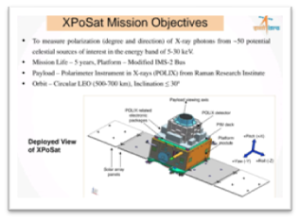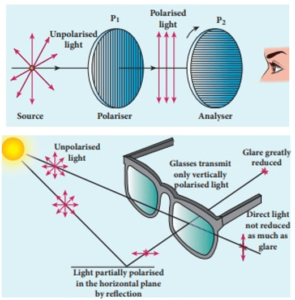
ISRO’s POLARIMETER
ISRO’s POLARIMETER
India’s X-Ray Polarimetry Astronomy Endeavour
India is poised to launch its inaugural X-Ray Polarimeter Satellite (XPoSat), signaling a significant advancement in space-based X-Ray astronomy.
This mission, distinguished by its focus on investigating the polarization of intense X-Ray sources, represents a substantial addition to traditional studies in time and frequency domains, generating heightened enthusiasm within the astronomy community.

XPoSat Mission Overview
- The XPoSat spacecraft is scheduled for observation from Low Earth Orbit, equipped with two scientific payloads to enable concurrent studies of temporal, spectral, and polarization features of bright X-Ray sources.
- The mission’s primary objectives include measuring X-Ray polarization in the 8-30 keV energy band and conducting long-term spectral and temporal studies of cosmic X-Ray sources in the 0.8-15 keV energy band.
- With an anticipated mission life of approximately 5 years, XPoSat will observe X-Ray sources during its transit through Earth’s shadow, particularly during the eclipse period.
X-Ray Polarization as a Diagnostic Tool
- X-Ray polarization, a critical diagnostic tool, unveils the radiation mechanism and geometry of celestial sources.
- The XPoSat mission by ISRO is purposefully designed to explore X-Ray polarization signatures emanating from bright X-Ray sources.
- The analysis of these signatures facilitates measurements of mass and spin in accreting black holes, elucidation of source geometry and local properties, exploration of accretion flow, outflow, and jets, and investigation into X-Ray scattering and reflection mediums, among other applications.
XPoSat Mission Payloads: POLIX and XSPECT
- Two primary payloads—POLIX (Polarimeter Instrument in X-rays) and XSPECT (X-ray Spectroscopy and Timing).
- These payloads are designed to provide comprehensive insights into the polarization, spectroscopy, and timing of X-rays emanating from diverse astronomical sources.
POLIX Payload: X-ray Polarimeter for Medium Energy Range (8-30 keV):
- POLIX is dedicated to measuring polarimetry parameters, specifically the degree and angle of polarization, in the medium X-ray energy range of 8-30 keV photons originating from astronomical sources.
- Developed by the Raman Research Institute (RRI), Bangalore, with support from ISRO centers.
- The instrument comprises a collimator, a scatterer, and four X-ray proportional counter detectors surrounding the scatterer.
- Objective: To observe a diverse range of bright astronomical sources across categories during the planned 5-year lifetime of the XPoSat mission.
- Significance: POLIX is notably the first payload in the medium X-ray energy band dedicated specifically to polarimetry measurements.
XSPECT Payload: X-ray Spectroscopy and Timing Instrument (0.8-15 keV):
- XSPECT provides spectroscopic information within the energy range of 0.8-15 keV and offers fast timing capabilities.
- Developed by the U R Rao Satellite Centre (URSC),
- Target Sources: Anticipated to observe a variety of sources, including X-ray pulsars, black hole binaries, low-magnetic field neutron stars (NS), active galactic nuclei (AGNs), and magnetars.
- Objective: Contribute to the understanding of soft X-ray emission dynamics and characteristics of various celestial bodies.
Understanding the Polarization of Light
- Light travels in the form of transverse electromagnetic waves. The light emitted by sources like the sun, bulb, candle etc. has vibrations in several planes (oscillates in all directions), and it is called unpolarised light.
- Polarisation is the phenomenon of restricting the vibration of light waves to one specific direction/plane. E.g., Polarised sunglasses have a special filter that allows only light with a specific polarisation direction to pass through, which helps to reduce glare and improve visibility by blocking unwanted polarisations.

Polarimetry: Polarimetry is a technique to measure the polarisation of light.
Unpolarized Light: In natural light sources, like the sun or incandescent bulbs, the electric field vectors of the light waves are randomly oriented in all directions.
Polarized Light: When the electric field vectors align predominantly in a specific direction, the light is said to be polarized.
Methods of Polarization:
- Transmission: Polaroid sheets or polarizing filters selectively allow light oscillating in a particular direction to pass through, blocking light with other orientations.
- Reflection: When light reflects off a surface, the reflected light can become partially polarized, with the degree of polarization depending on the angle of incidence.
- Scattering: Certain materials or particles scatter light in a way that preferentially polarizes the scattered light. An example is Rayleigh scattering, where shorter wavelengths scatter more and are more polarized than longer wavelengths.
Degrees of Polarization
The degree of polarization quantifies the extent to which light is polarized.
It is expressed as a percentage, where 0% represents completely unpolarized light, and 100% represents fully polarized light.
Applications:
Sunglasses: Polarized sunglasses reduce glare from reflective surfaces by blocking horizontally polarized light.
LCD Screens: Liquid crystal displays (LCDs) use polarization to control the passage of light, resulting in vibrant and clear images.
Communication Devices: Polarization is utilized in various communication technologies, such as antennas and satellite communication, to control signal transmission.
Photography: Polarizing filters in photography enhance contrast, reduce reflections, and improve colour saturation.
Scientific Research: In fields like astronomy and materials science, studying polarized light provides valuable information about the composition and properties of substances.

Significance of Polarization of Light in Astronomy
- Polarized light is a valuable tool for studying magnetic fields in space.
- Certain astronomical objects, like stars, galaxies, and nebulae, exhibit polarized light patterns that provide information about the strength and orientation of magnetic fields within them.
- In astronomy, polarization helps researchers study the environments around stars.
- It allows scientists to explore the structures of dust clouds, disks, and other materials surrounding stars, giving clues about the formation of planetary systems.
- Polarimetry allows astronomers to observe and measure characteristics of objects, which include:
- Size, shape and orientation of dust particles, such as those surrounding comets or in planet-forming discs around stars.
- Light from faint sources, such as exoplanets or hidden galactic nuclei.
- Scattering properties of light-reflecting bodies (such as planetary atmospheres and the surfaces of rocky bodies).
- Three-dimensional shapes of objects, such as supernovae.
- Magnetic fields around stars and other objects, such as black holes.